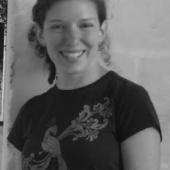Dracula! Singing and dancing

I know I’m usually the one trying to unpack the social implications of theater and trying to figure out why a particular theater company has decided to stage a particular show at any given moment. But at a certain point, when reading about COLLIDE’s production of Dracula in the Pioneer Press, I had entirely the opposite reaction. When it comes to a jazz dance musical adaptation of Dracula, there’s such a thing as trying too hard to find its social relevance.
COLLIDE has re-staged Bram Stoker’s Dracula in present-day New York, where Dracula purchases a condo from Jonathan Harker and struggles to fit into a new social circle of relatively affluent New York couples. This narrative shift, according to the Pioneer Press article, is supposed to get us thinking about debates on immigration and how challenging it is to assimilate into a new culture.
Viewing the production, however, I saw very little of all that – but what I did see was loads of fun. Why try to force a sociopolitical narrative onto what is really just a superbly executed good time?
Turns out that the story of Dracula is surprisingly well-suited to a dance musical. The dance numbers are set to an intense backdrop of music by artists like Lady Gaga, Radiohead, and Nirvana, all played by an excellent live band. Some of the numbers are sung by Katie Gearty, while others are performed by Michael Hanna, as Dracula himself. Both vocalists achieve exactly the raw quality you’d hope for in a musical Dracula – sometimes aggressive, sometimes sensual, and always hitting just the right balance of darkness and light.
And while I don’t know much about dance technique, I can tell you that the entire ensemble of dancers stunned me. Not only are their leaps and spins impressive, but their timing in the group numbers is amazingly well-coordinated. Regina Peluso’s choreography is varied and interesting, and she makes very good use of her source material, from the more carefree celebration of Lucy and Arthur’s wedding to the unpredictable scenes with Renfield in the asylum.
As for the featured dancers, the women particularly stand out. (They also have more distinctive personalities to work with, since the series of vampire-hunting gentlemen blends together a bit.) Regina Peluso does an incredible job as the spastic, frightened inmate Renfield, and Jami Snively goes through quite the living-to-undead transformation as Lucy. Renee Guittar is also compelling as Mina: the production struggles a bit to make Mina more than just the object of Dracula’s interest, but it largely succeeds thanks to Guittar’s strong performance.
You might notice that I haven’t mentioned Michael Hanna’s dancing as Dracula. That is because Dracula doesn’t dance. This initially didn’t make much sense to me, although it’s also hard to imagine how you’d choreograph the Prince of Darkness. Going back to that Pioneer Press interview, director Joshua Campbell explains that Dracula doesn’t dance in order to highlight his outsider status. Dracula quite literally speaks a different language than the rest of the cast, expressing himself in song rather than in dance.
Whatever. Hanna has an amazing voice, so if the production has him focus on singing rather than trying to sing and dance at the same time, I have no complaints.
Dracula is also designed well, with a simple, two-level set and moody lighting by Jessie Cogswell. The dancers also make use of the Ritz’s side aisles, as well as the central aisle dividing the front and the back of the house, so if you sit too far forward you might need to turn around quite a bit to catch all of the action. I had a perfect view from my seat in the very front of the back section, and it was nice to get to see the dancers close up, even seated further back from the stage.
My experience with COLLIDE’s Dracula is certainly slanted by my fairly poor knowledge of dance and the dance world. Knowing little about trends in dance, I do wonder whether the parallels Joshua Campbell draws between Dracula’s outsider status and current debates on immigration are in response to a broader call for social relevance within the dance community. If so, I would love to know more about those trends and how artists are connecting their work to current events.
As a non-dance person, I know that dance is sometimes perceived as an aesthetic realm that is hard for outsiders to connect to, so I appreciate COLLIDE’s effort to make Dracula intellectually interesting, as well as being accessible and pleasing to watch. But when you get right down to it, Dracula’s combination of familiar music, gripping choreography and a dynamic ensemble makes it a purely fun and exciting night out – no intellectual strings attached.
Speaking of current relevance, though, did you know that Dracula’s castle is up for sale for as little as $13 million?




